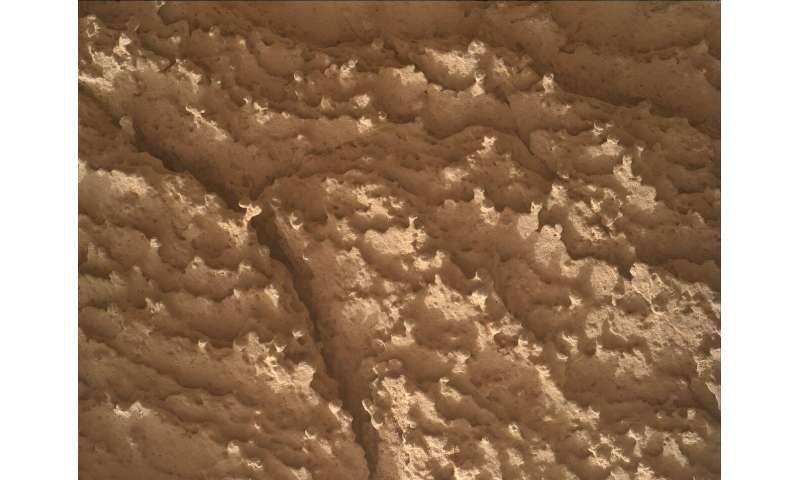Sols 4188–4190: Aurora watch on Mars

During the night of May 10, Earth experienced a fantastic display of aurorae (northern and southern lights) which extended all the way to tropical latitudes, courtesy of the strongest geomagnetic storm since 2003.
The enormous solar active region 3664, which produced the X-class flares and powerful coronal mass ejections powering this magnetic storm, has since rotated away from Earth. However, this explosive sunspot group now faces Mars.
Just as the active region rotated into Mars view, it unleashed the largest flare in 20 years, an X8.7 monster. This solar flare also aimed a coronal mass ejection (CME) at Mars, which is potentially capable of producing auroras.
Given Mars' lack of a global magnetic field, Martian aurorae are not concentrated at the poles as they are on Earth, but instead appear as a "global diffuse aurora" that are associated with Mars' ancient, magnetized crust.
One of the planned observations for Curiosity this weekend will be a night-time 12x1 Mastcam observation of the sky above Texoli Butte, in a hope to capture one of these elusive Martian aurorae.
Contact science on "Tuolumne Meadows" and "Parker Lakes" on sol 4187 completed successfully. The included picture is a MAHLI image of "Parker Lakes" taken on Sol 4187, which shows abundant bedrock nodules, some perched on tiny stalks like a miniature version of the hoodoos in Bryce Canyon National Park.
Unfortunately, the drive on sol 4187 faulted after 10 m due to a steer stall on the right rear wheel, and the resulting wheel placement was too uncertain to support contact science. Our current plan skips sol 4188, as Earth passes are too low on the horizon for Curiosity to successfully receive commands for that sol.
On Sol 4189, Curiosity will observe the layered bedrock target "Polemonium Pass" with ChemCam LIBS and Mastcam, as well as more distant white rocks around "Falls Ridge" with ChemCam RMI and Mastcam.
The first target is named for a 11,600 ft pass near the northern border of Yosemite National Park. The word "Polemonium" refers to Polemonium eximium, the skypilot or showy sky pilot alpine flower only found above 10,000 feet in the Sierra Nevada. The target name "Falls Ridge" honors a towering ridge-line of granite domes forming the southern wall of the Grand Canyon of the Tuolumne River.
All targets in this area of Mount Sharp are named after the Bishop geological quadrangle in the High Sierra and Owens Valley of Calfornia. Mastcam will also image a nearby troughs between the blocky rocks surrounding the rover. Atmospheric observations in this science block include a dust devil survey, atmospheric opacity measurement, Navcam suprahorizon movie, and rover deck image.
Curiosity will then perform a block of atmospheric observations with APXS and SAM to measure atmospheric constituents. Well after dark, Mastcam will search for aurora in the sky above our rover.
Curiosity starts the next sol (4190) with a ChemCam LIBS and Mastcam observation of "The Fissures," a finely laminated bedrock target named for a deep bedrock joint on the south wall of Yosemite Valley. This is followed by a 10x1 RMI mosaic of Texoli butte, ChemCam passive sky, deck monitor, and dust devil survey.
Curiosity will then start its 27-mile drive, finishing near the lip of the Gediz Vallis channel. After the drive ends, Curiosity will perform its usual post drive panoramic imaging and take a MARDI frame of the ground under the rover.
The next morning, Curiosity will perform early morning atmospheric observations including Mastcam solar tau to measure dust in the atmosphere, Navcam opacity measurement, and Navcam zenith and suprahorizon cloud movies.
On Monday, we will do contact science at the new location, then decide where to drive across the channel sands on our way up Mount Sharp.
Provided by NASA